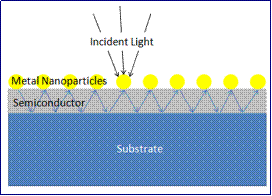Enhanced Solar Cell Engineering

Plasmonic solar cells are being designed to harness the light trapping capabilities of nano structures. Currently solar cells are made of very expensive raw materials causing the cost of solar energy to be prohibitive. Placing metal nano particles on the surface of solar cells allows engineers to design smaller cells that trap light energy efficiently using less costly materials and the characteristicsof metallic surface plasmons.
Nanoscale Biosensoring

When light is projected onto a metal nano film characteristic absorption and transmission patterns will be detected. If the film is coated with biological receptors i.e. antibodies to a specific molecule then those patterns will change. By knowing before antibody exposure and after antibody exposure absorption patterns instruments can be calibrated to give quantities of molecules present. This application is used in early tumor detection and location. It can also be used as a chemical analyzer on a postage stamp sized surface. This could be used in remote places where chemical analyzers are not available.
Nanoscale computer chip

In a traditional microchip electrons move along a silicon layer of Atoms making connections, and carrying digitized information. The new generation of computer chips will use the light Propagating properties of surface plasmons to move light instead of electrons From one place to another on the microchip carrying digitized information. The light will not need any silicon atoms to facilitate the transport. It will move in a nano sized wave guide. This will speed up the processing rate tremendously (speed of light!) and bring down the size of a microchip.
Specialized coatings

Because nano particles can be ‘tuned’ to absorb specific wavelengths according to their shape and size they can be used to hide objects that would normally be detected using radar or some sort of electromagnetic wave. The nano particle can be added to a plastic or adhesive like paint or epoxy and coated on the surface of the object. It sounds crazy but an invisibility cloak is on it’s way!